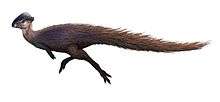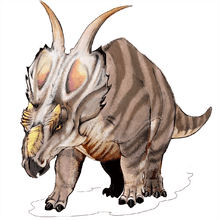Vagaceratops
| Vagaceratops Temporal range: Late Cretaceous, 75 Ma | |
|---|---|
 | |
| Cast of the type specimen, Canadian Museum of Nature | |
| Scientific classification | |
| Kingdom: | Animalia |
| Phylum: | Chordata |
| Class: | Reptilia |
| Clade: | Dinosauria |
| Order: | †Ornithischia |
| Family: | †Ceratopsidae |
| Subfamily: | †Chasmosaurinae |
| Genus: | †Vagaceratops Sampson et al., 2010 |
| Species: | †V. irvinensis |
| Binomial name | |
| Vagaceratops irvinensis (Holmes et al., 2001 [originally Chasmosaurus]) | |
| Synonyms | |
| |
Vagaceratops (meaning "wandering (vagus, Latin) horned face", in reference to its close relationship with Kosmoceratops from Utah) is a genus of herbivorous ceratopsian dinosaur. It is a chasmosaurine ceratopsian which lived during the Late Cretaceous period (late Campanian) in what is now Alberta. Its fossils have been recovered from the Upper Dinosaur Park Formation.[1]
Classification



Vagaceratops is characterized by a short nose horn and brow horns that are reduced to low bosses. The frill is distinctive in being square shaped, with a row of ten, forward-curving hornlets along the back. The genus was named by Scott D. Sampson, Mark A. Loewen, Andrew A. Farke, Eric M. Roberts, Catherine A. Forster, Joshua A. Smith, and Alan L. Titus in 2010, and the type species is Vagaceratops irvinensis.[1] This species was originally described as a species of Chasmosaurus (C. irvinensis) in 2001.[2] Its relationships remain debated. Vagaceratops has variously been allied with Kosmoceratops[1] or with Chasmosaurus.[3][2]
The following cladogram shows the phylogeny of Chasmosaurinae according to a study by Scott Sampson e.a. in 2010.[1]
| Ceratopidae |
| |||||||||||||||||||||||||||||||||||||||||||||||||||||||||||||||||||||||||||||||||||||||
| |
See also
References
- 1 2 3 4 Scott D. Sampson, Mark A. Loewen, Andrew A. Farke, Eric M. Roberts, Catherine A. Forster, Joshua A. Smith, and Alan L. Titus (2010). "New Horned Dinosaurs from Utah Provide Evidence for Intracontinental Dinosaur Endemism". PLoS ONE. 5 (9): e12292. doi:10.1371/journal.pone.0012292. PMC 2929175
 . PMID 20877459.
. PMID 20877459. - 1 2 R. B. Holmes, C. A. Forster, M. J. Ryan and K. M. Shepherd (2001). "A new species of Chasmosaurus (Dinosauria: Ceratopsia) from the Dinosaur Park Formation of southern Alberta". Canadian Journal of Earth Sciences. 38: 1423–1438. doi:10.1139/cjes-38-10-1423.
- ↑ Longrich, N.R., 2011. Titanoceratops ouranos, a giant horned dinosaur from the Late Campanian of New Mexico. Cretaceous Research 32, 264-276.
External links
- Vagaceratops irvinensis at the Canadian Museum of Nature


